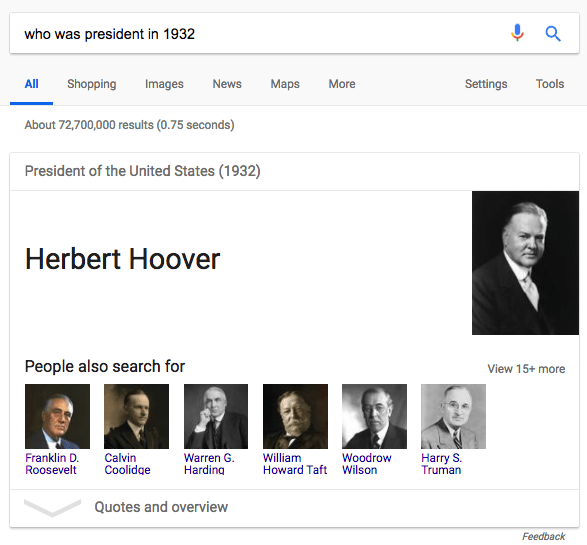Search engine optimization has always been doggedly focused on the first position of the search engine results page (SERP). Getting a listing to rank in this coveted position—the highest and therefore the most visible organic search listing—is the holy grail of any SEO campaign. In recent months, however, Google has flipped the script, offering marketers an even higher ranking to aspire to: position zero.
As its name suggests, this SERP position arrives ahead of the #1 ranking—making it an even more valuable piece of online real estate. Position zero is occupied by featured snippets—pieces of rich content that provide search engine users with the answers they seek, presented directly on the SERP itself. (In other words, search engine users can get their answer without having to click on an actual link.)
What are Featured Snippets?
Featured snippets come in many varieties; they may include brief paragraphs of text, but just as often they encompass numbered lists, tables, images, charts, recipes, or YouTube videos.
To see an example of a featured snippet, go to the Google search bar and type this query: who was president in 1932. Google will present you with the answer to your question (Herbert Hoover) right there on the SERP; there’s no need for you to navigate to any further source to discover the information you’re after.

(Featured Snippet Example)
Obviously, getting a featured snippet listing for your business can have major benefits—including greater SERP visibility, an increase in traffic, and a major boost to your credibility. The question is, how can you get content into this coveted SERP position?
Ranking for Position Zero
When trying to rank for position zero, there are a number of factors to consider—including your subject matter, the brevity of your content, and even the way your content is formatted. Here are a few guidelines.
Answer Basic Questions
The most common use of featured snippets is to answer a basic, factual question—a who, what, when, where, or why question, such as the Herbert Hoover query we listed above. Note that the complexity of the question can’t be too great; if it’s impossible to answer the question in less than a thousand words, it’s obviously not going to fit into a featured snippet. At the same time, the question can’t be too simple, or else Google will simply furnish a public domain answer from its own database. That’s where the Herbert Hoover example takes us.
The sweet spot is in answering a question of middling difficulty—not so complex that Google skips straight to tis organic listings, and not so simple that it can be answered directly from Google’s well of public knowledge. (Example: For the query did Herbert Hoover start the Great Depression, Google offers a featured snippet from Wikipedia.)
In your content, try to think of some of these middling-complexity questions that search engine users might be asking, specifically ones related to your industry or niche. Here, rank-tracking and keyword research tools can be invaluable to you as you brainstorm different phrasings of these common questions.
Offer Instructions
Another guideline: Often, featured snippets are used to answer how-to or instructional queries. If your content walks users through a particular process, or teaches them how to do something, that ups your chances of making it into position zero.
There are different ways to furnish Google with this kind of content—among them:
- Recipes
- Step-by-step tutorials
- Tutorial or how-to videos
By focusing on imparting a certain skill or procedure, you can rank your content for these queries, possibly even in that coveted featured snippet space.
Define a Term
Another approach you might take is defining a complex term. Desktop and mobile searchers will often conduct a Google query for a simple word or phrase—for example, PPC—because they want that term defined.
Think of some words or phrases from your industry that people might need to have defined, then create a landing page in which you offer a good, thorough definition. And don’t leave it there; build out your content beyond that simple definition. For example, you might make a landing page where you define PPC, then list some more robust PPC strategies.
Providing a comprehensive resource like this can significantly boost your chances of making it into position zero.
Provide a Comparison
Something else that can help you rank in a featured snippet is comparing and contrasting two different but related things—for example, two different phone brands, or two different types of fish.
Here, formatting can work to your advantage. A simple table, illustrating the similarities and differences between your two entities, presents information in a clear and visually appealing way. That’s just the sort of thing that Google likes to offer to its search engine users.
Make a Ranked List
Google search engine users love lists—or at least, they like to see rankings of “best” and “greatest” things. For example, it’s not at all uncommon for consumers to conduct searches for best phone case, best vacuum cleaner, or something similar.
Formatting your content as a ranked list of recommendations can help you appeal to these users, and thus rank well on the SERP. For example, if you run a used auto dealership, a blog post that lists your top 10 small sedans can be an excellent way to format consumer-friendly information.
Create Content That’s Made to Rank
Of course, generating content that ranks well on the Google SERP is always a priority for digital marketing—and it’s something we can help with here at enCOMPASS. Let’s talk today about helping your content make it higher and higher up the SERP. Reach out to enCOMPASS today for a consultation.
SHARE THIS ARTICLE:



